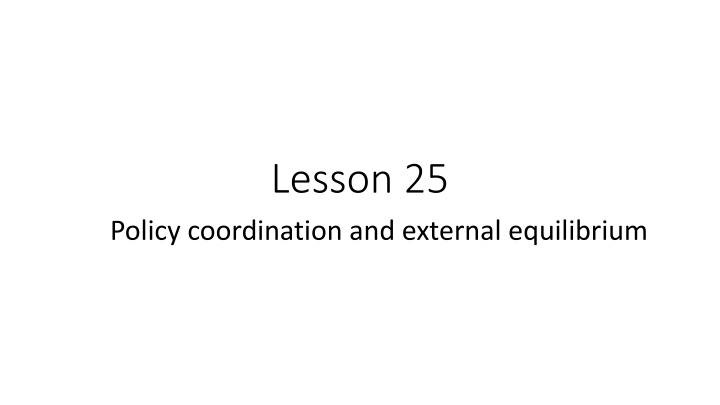
Policy Coordination and External Equilibrium in the Eurozone
Explore the significance of external equilibrium in the European Monetary Union, national account identities, and the relationship between national accounts and the balance of payments. Learn how the Eurozone operates under a fixed exchange rate regime and the mechanisms involved in maintaining economic stability.
Download Presentation

Please find below an Image/Link to download the presentation.
The content on the website is provided AS IS for your information and personal use only. It may not be sold, licensed, or shared on other websites without obtaining consent from the author. If you encounter any issues during the download, it is possible that the publisher has removed the file from their server.
You are allowed to download the files provided on this website for personal or commercial use, subject to the condition that they are used lawfully. All files are the property of their respective owners.
The content on the website is provided AS IS for your information and personal use only. It may not be sold, licensed, or shared on other websites without obtaining consent from the author.
E N D
Presentation Transcript
Lesson 25 Policy coordination and external equilibrium
The issue of external equilibrium in EMU In an irrevocably fixed exchange rate, the external equilibrium plays a crucial role since it may represent a source of great real and financial instability. In the presence of perfect capital mobility and an interest rate defined at the level of the whole currency union, the balance of payments should not register excess discrepancies in its items. This is due to the direct link connecting internal and external equilibria and to the need to achieve equal saving and investment in the presence of inflows and outflows of capital from abroad.
National account identities The identities of national accounts state that the sum of private saving (Y-C) and public saving (T-G) equals investment (I) plus the net value of the current account (CA) . This can be expressed as: (Y-T)+(T-G)=I+CA or Sp-D=I+CA such that the current account deficit covers the difference between national saving (both public and private) and domestic investment. In other words, if savings exceed investments a current account surplus occurs, while if investments exceed savings, imports are greater than exports.
National accounts and the balance of payments The difference between savings and investments can be financed through the inflow of capital and vice versa such that in equilibrium: if CA>0 then it has to be CF>0 if CA>0 then it has to be CF<0 as stated by the balance of payments account equation BP= CA+CF=0 In other words if an excess of public deficit occurs it corresponds to a current account deficit, which needs to be covered by capital inflows. Under a pure regime of floating exchange rates, the relative price of currency, in principle, automatically puts the balance of payments in equilibrium such that eventual persistence of the current account deficit is the result of investor preferences in the investment in the country considered. Under a fixed exchange rate regime, the following formula holds: BP= CA+CF= FR This implies that the decrease (increase) in foreign reserve currency (FR) covers the current account deficit (surplus) which private capital does not finance. Unfortunately, foreign currency reserves can only cover discrepancies between current account and capital flows for a limited period of time.
Eurozone as a fixed exchange rate regime There is only one currency national reserve in foreign currencies cannot be considered a mechanism of adjustment There is a particular settlement mechanism, TARGET (evolving into TARGET2). Under TARGET2, countries with a balance of payments surplus receive, via their national central bank, the net credit from the balance of payments deficit of another country. Deficit countries, in turn, have a net debt with surplus countries, the cost of which is determined by the interest rates set by the ECB for the European banking system.
Before the 2007 financial crisis The Target settlement mechanism between Eurozone banks functioned well in an integrated capital market. As predicted in the Mundell-Fleming model, capital migrated from one country to another according to the very limited interest rate differential, under the protective umbrella of confidence in the common currency. Until the 2007 financial crisis, the difference between saving and investment was actually considered a good opportunity for capital from surplus countries to flow towards deficit ones in order to gain better returns. In this way, current account imbalances could be considered predictors of a uniform rate of growth. Public bonds were safe and the spreads between them were almost negligible.
Long Long- -term account account as as a a percentage 2004 2004- -2007 2007 term interest interest rates percentage of of GDP rates on on government government bonds GDP in in selected selected Eurozone bonds and Eurozone countries and current current countries
After the 2007 financial crisis Large quantity of investment resulted in a consumption boom rather than in converging rates of growth. Once the crisis hit aggregate demand and revealed the structural differences among Eurozone countries, it was the current account which became the proxy for financial markets to evaluate a country s ability to repay its debts. Countries with a current account deficit experienced outflows of capital and increases in interest rates. The resulting real effects gave impetus to capital flight, important once again and suddenly TARGET 2 had to register discrepancies between components in the balance of payments. Target2 in times of crisis, reveals other flaws which do not occur in a fixed exchange rate regime, as well as the limits of the Euro currency area: 1) there is only one currency such that the relative price adjustment mechanism either does not work or works much more slowly; as a general principle, increasing inflation would lead automatically to the realignment of the exchange rate. However, the existence of a common currency slows down the process of adjustment and increases the burden on deficit countries; 2) it open-endedly finances speculative movement of private capital. In a period of lack of confidence it boosts capital flight from periphery to core countries, increasing the need to refinance deficit and debt through increased interest rates. national borders became
Long Long- -term account account as as a a percentage ( (2008 2008- -11 11) ) term interest interest rates percentage of of GDP rates on on Government Government bonds GDP in in selected selected Eurozone bonds and Eurozone countries and current current countries
Analogies with 1992 SME crisis in the 1992 currency crisis the UK and Italy, faced sharp capital outflows, exhaustion of foreign currency reserves and interest rate increases and were forced to restore monetary independence and to devalue their currencies. This alternative is no longer available. When countries join the Eurozone, they decide to give up monetary independence, share a common currency, i.e. an irrevocably fixed exchange rate regime, and to let capital move freely across countries. Under such circumstances, there exists a policy trilemma according to which it is impossible to have simultaneously exchange rate stability, free capital mobility and monetary policy independence. For the Eurozone Member States, choosing between these three is no longer available unless they consider exiting the currency area as a possibility
The Eurozone policy trilemma The Eurozone countries cannot share with other Member States all three objectives of financial integration, financial stability and fiscal independence, meant as the ability to use fiscal policy as a stabilization instrument. In the absence of monetary policy autonomy and a supranational fiscal policy there is a Eurozone trilemma In the Eurozone, the ability to use fiscal policy does not result from autonomous choices but from financial market stability and the degree of financial integration, i.e., the degree of substitutability of internal and external assets. Therefore, choosing to share a common currency means being unable, in the case of financial instability, to use fiscal policy for internal objectives, unless perfect capital mobility is given up, in contrast with the building pillars of the Euro-area.
Two alternative future scenarios 1. The first in which European institutions insist on the efficient working of the trilemma. Under this scenario, single states are asked to make adjustments on their own. In particular, countries with unsound fiscal dynamics and balance of payments deficit have to bear the whole cost of rebalancing the currency area, implementing fiscal retrenchments and reducing their current account deficit, while the others, in spite of having profited from the weakness of the Euro, remain at best passive onlookers. 2. The alternative scenario is to remove trilemma constraints. It relies on the premise that fiscal retrenchment and real devaluation further depress internal demand, making it even more difficult to repay debts. In the presence of persistent negative shocks, Eurozone asymmetries cannot be realigned without shared policy action: the existence of the trilemma highlights the presence of national constraints and suggests, for the future existence of the Eurozone, a drive towards centralized fiscal policy instruments. However, a quantum leap towards a political union would be required.






















